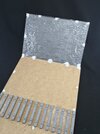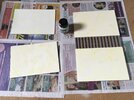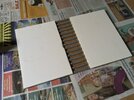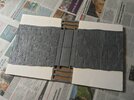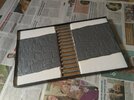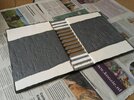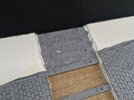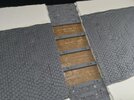- Joined
- Apr 28, 2018
- Messages
- 10,797
- Points
- 113
- First Name
- Jakko
Needing a quick break from the ton of work that is the Landing Craft, Assault model, I opened up the MiniArt railway crossing I purchased not long ago, to build it as a generic base for photographing models on.
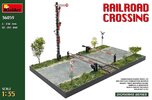
I didn’t take photos of the parts in the kit, but basically, you get two vacuum-formed sections of road with verges, a length of railway track (standard gauge, not Russian 1524 mm, despite this kit coming from Ukraine), wooden beams and things to make the actual crossing between the rails, two barriers, a signal post, and two street signs to warn of the crossing. It’s all very well-moulded, though the street sections being vacuum-formed was slightly disappointing — even if I had actually expected them to be
The box says that assembled, it’s 265 × 430 mm, but it’s actually more like 258 × 428 mm. I went to the local hardware store and had them saw me a piece of 5 mm MDF to 26 × 43 cm, to use as a base plate, because you need to provide one yourself — there is no way to assemble the pieces together straight from the box. This set me back all of €1.20, so I was glad I hadn’t bothered to dig deeper around the house for something I could saw to size myself
I first glued the two street plates to the MDF, using thick construction adhesive, which I dabbed into the corners and at a few places along the sides. I didn’t want to try and glue the whole edges down, as that probably would have made a big mess. I simply stuck them almost into the corners, and when the glue was still wet, put a sleeper at either end of the gap down the middle to check the spacing. Once the glue had dried, I measured out the positions for the sleepers so they would be evenly spaced. The instructions don’t say how many you need, but I counted fifteen, so that’s what I went for. It turns out that if you put one sleeper at each end, level with the vacuum-formed parts, you need to put one down every 18 mm — that’s not the space between them, but from left edge to left edge.
The next day (that is, today), I smeared the whole central part with contact cement and also applied that to the bottoms of the sleepers; after letting it dry for about 15 minutes, I stuck them all on:
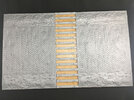
You may notice I didn’t bother to clean up the sprue attachment points. Doing that would just be unnecessary work, as they will be covered later anyway. I only cleaned them up on the two outward faces.
However, having fitted the sleepers, I now have a problem that should have occurred to me earlier. Trying on the rails and the wooden beams between them, what you have is no so much a railway crossing, as a speed bump:
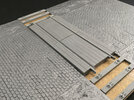
I’m debating what to do. One option is to cut the streets from the base again and raise them up to the level of the crossing. The other is to cut the ends of the beams into a triangle so I can do this:
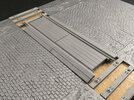
This works because the beams are hollow, so I can just trim the sides so they can fit like this on top of the sleepers rather than between them like in the photo (they’re moved to the side a bit here to illustrate the effect this would have).
I’m not sure how believable the second option is, though — and it would make it hard to display a model on the base, because it would likely end up on the raised bit with a suspension that’s not adapted for it.
A third option would be to cut the road out and raise up only the side at the crossing. However, that causes much the same problem with suspensions …
Anyone have thoughts or ideas on how to do this? I’m leaning to removing the road from the base again and raising the whole thing, but maybe someone has a better idea?

I didn’t take photos of the parts in the kit, but basically, you get two vacuum-formed sections of road with verges, a length of railway track (standard gauge, not Russian 1524 mm, despite this kit coming from Ukraine), wooden beams and things to make the actual crossing between the rails, two barriers, a signal post, and two street signs to warn of the crossing. It’s all very well-moulded, though the street sections being vacuum-formed was slightly disappointing — even if I had actually expected them to be

The box says that assembled, it’s 265 × 430 mm, but it’s actually more like 258 × 428 mm. I went to the local hardware store and had them saw me a piece of 5 mm MDF to 26 × 43 cm, to use as a base plate, because you need to provide one yourself — there is no way to assemble the pieces together straight from the box. This set me back all of €1.20, so I was glad I hadn’t bothered to dig deeper around the house for something I could saw to size myself

I first glued the two street plates to the MDF, using thick construction adhesive, which I dabbed into the corners and at a few places along the sides. I didn’t want to try and glue the whole edges down, as that probably would have made a big mess. I simply stuck them almost into the corners, and when the glue was still wet, put a sleeper at either end of the gap down the middle to check the spacing. Once the glue had dried, I measured out the positions for the sleepers so they would be evenly spaced. The instructions don’t say how many you need, but I counted fifteen, so that’s what I went for. It turns out that if you put one sleeper at each end, level with the vacuum-formed parts, you need to put one down every 18 mm — that’s not the space between them, but from left edge to left edge.
The next day (that is, today), I smeared the whole central part with contact cement and also applied that to the bottoms of the sleepers; after letting it dry for about 15 minutes, I stuck them all on:

You may notice I didn’t bother to clean up the sprue attachment points. Doing that would just be unnecessary work, as they will be covered later anyway. I only cleaned them up on the two outward faces.
However, having fitted the sleepers, I now have a problem that should have occurred to me earlier. Trying on the rails and the wooden beams between them, what you have is no so much a railway crossing, as a speed bump:

I’m debating what to do. One option is to cut the streets from the base again and raise them up to the level of the crossing. The other is to cut the ends of the beams into a triangle so I can do this:

This works because the beams are hollow, so I can just trim the sides so they can fit like this on top of the sleepers rather than between them like in the photo (they’re moved to the side a bit here to illustrate the effect this would have).
I’m not sure how believable the second option is, though — and it would make it hard to display a model on the base, because it would likely end up on the raised bit with a suspension that’s not adapted for it.
A third option would be to cut the road out and raise up only the side at the crossing. However, that causes much the same problem with suspensions …
Anyone have thoughts or ideas on how to do this? I’m leaning to removing the road from the base again and raising the whole thing, but maybe someone has a better idea?


 Though if I hadn’t, it would be a lot less work to build the base with raised sections under the road from the start.
Though if I hadn’t, it would be a lot less work to build the base with raised sections under the road from the start.